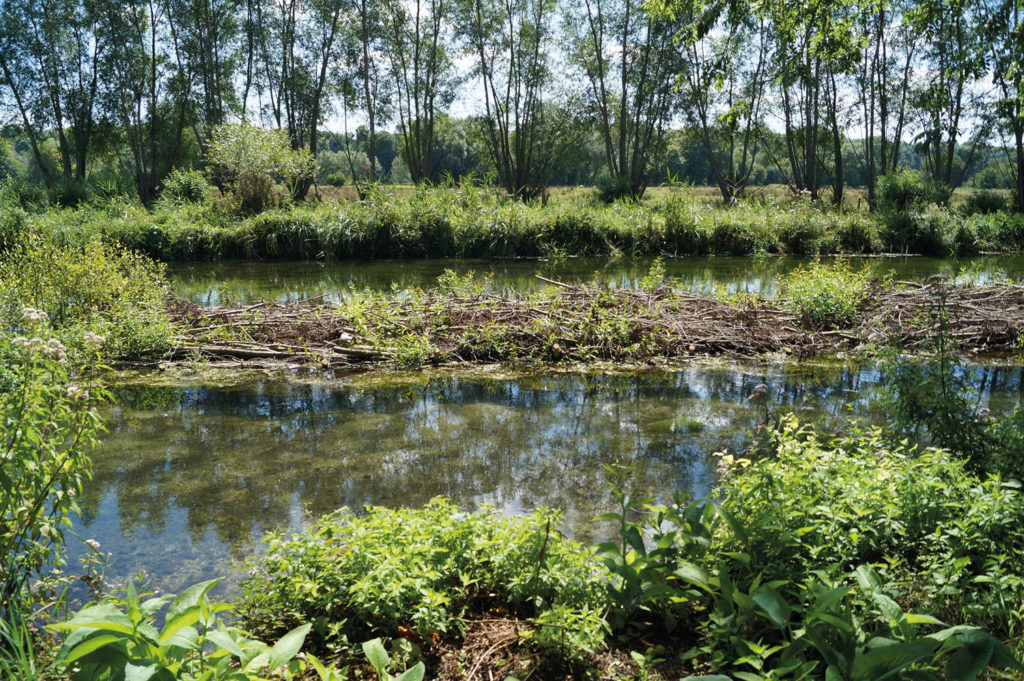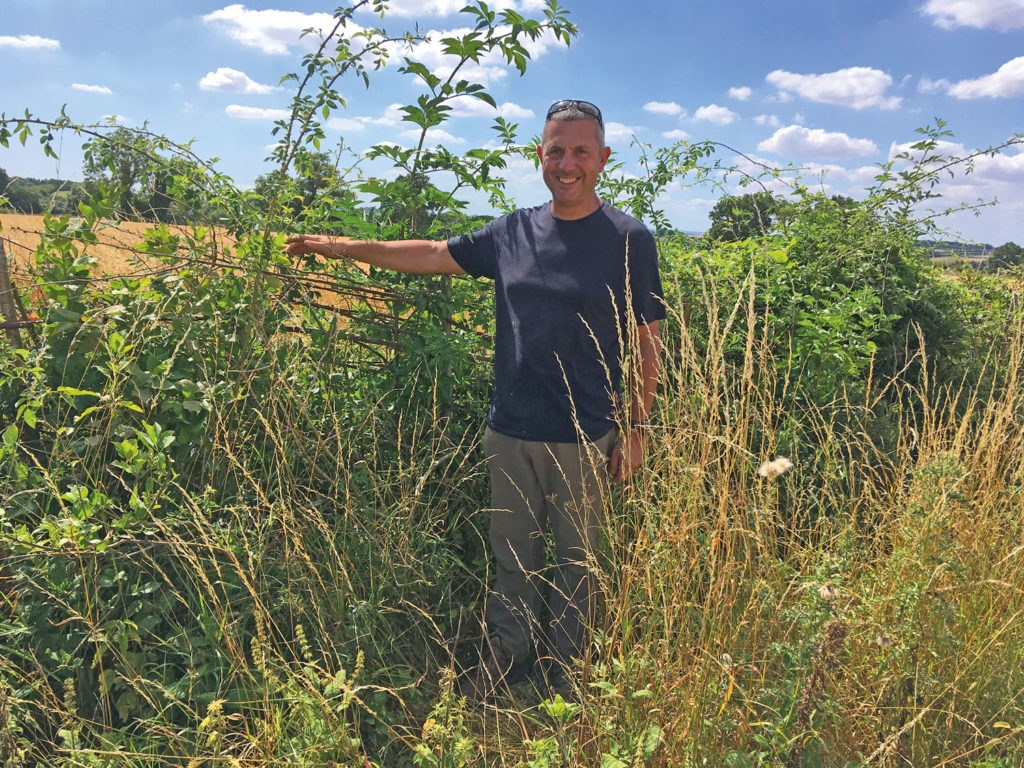From restoring a stretch of chalk stream, to designing an oak wood for woodcock, Richard Wills is leading a wide range of pioneering projects on his family’s estates in Hampshire

Richard Wills has a record of breaking new ground with conservation on the Middleton, Portway and Wades estates. His team won a Laurent Perrier Award in 1990 for rewetting the water meadows for waders, and in 2016 they received a Purdey Award for grey partridge restoration. He is currently rewilding three miles of the Test as well as researching how to improve woodland for woodcock.
Alan Walters, headkeeper on the 1,800-acre wild gamebird project, increased the rare grey partridge from one to 60 pairs in eight years and a count of 500 birds is anticipated this autumn. After ten years, grey partridge numbers are stable and the wild pheasant and redleg populations have gone from strength to strength with bags for the season rising from 50 to 1,000 in the first five years and still increasing. Since the project started, a wide range of threatened farmland species including skylark, yellowhammer, lapwing and stone curlew have benefited from the game management measures.
Farm facts
- Location: North West Hampshire
- Type of farming: arable and water meadows
- Acreage: 6,500 (combined estates)
- Funding grants: HLS, Capital Grant Scheme
Richard said: “As a shoot manager you have to ask yourself, have you enhanced the countryside? Have you put back more than you have taken? It should be a natural instinct to try to increase your wild pheasant population.”
A great deal of work has gone into building up the wild birds. First on habitat creation where the farming operation, run by contracting company HLM Agri Ltd and overseen by estate manager Chris Hewitt, plays a central role. After taking advice from the GWCT, the farm put in 4,500 metres of beetle banks, 53,000m of six-metre conservation headlands, 16 hectares of brood-rearing cover and bird seed mix and restored 6,000m of hedges. Other major changes to the farming were stopping night-time operations and perhaps most importantly, reduced field sizes, creating an impressive 16 fields out of five and adopting more varied crop rotations.
Combining farming and conservation is challenging. Chris said: “The payment side is overly bureaucratic and often delayed. It would be better if the agri-environment schemes were more flexible, but we are lucky to have Harold Makant who has been our Natural England advisor for 20 years. He knows our track record, so he helps us through the bureaucracy with advice and derogations when necessary.”
Though payments through agri-environment schemes are essential, they don’t cover costs. For example, the net cost of capital works in the most recent (2013) Higher Level Stewardship (HLS) scheme has been £50,000. But the estates are being run efficiently, so they can afford the conservation work and still reinvest in the businesses.
Richard said: “It is about having a holistic approach whereby the property side and the farming provide an income while also paying for river, shoot and woodland management. But it’s very important to get the message to government that the driver is the possibility of flushing a wild grey partridge or catching a wild trout. We haven’t shot a single grey partridge and yet that gamebird has inspired ten years of conservation of huge benefit to biodiversity.”

An essential part of making the wild shoot a success was employing a second keeper and upgrading equipment with the addition of night-vision. Brown hares have seen a dramatic increase thanks to efficient fox control. Fox and crow numbers are now at a manageable level, but the remaining threat to wild birds and hares are raptors, in particular buzzards, red kites and female sparrowhawks. Winter losses to raptor predation are a major factor in halting the grey partridge population growth, particularly in the period after Christmas when they pair up and don’t have a covey for protection.
Richard likes to see birds of prey but struggles to understand the logic behind the current licensing system. He said: “After killing a leveret, buzzards are often driven off by a red kite and so go on to kill another hare. We have a big enough population to cope with that, but if you were trying to get hares back from scratch you might be wasting your time. I can get a licence to kill a cormorant to protect my fish and the brown trout is not a rare thing, but I wouldn’t get a licence to control another protected species, whose numbers are increasing, to save lapwing or stone curlew, which are much rarer.”
“If we don’t put something back, we’ll lose it and deserve to”
Richard’s current focus is a ten-year plan to transform a previously intensively stocked fishery to a purely wild trout stretch of the Test. This was inspired in part by the promise of better fishing. He said: “A wild trout is so much more challenging and rewarding to catch than a stocked fish. Restoring the fishery to how it once was is very satisfying.”
Before the project began three years ago, trout were being released on a large scale and the syndicate operated a catch-and-release policy. As part of the rewilding project, the fishing pressure was reduced and grayling are no longer fished during the trout spawning period. Richard said: “The loss of cash flow is significant, but the conservation dividend that will come in the long term makes it worthwhile.”
A beat has been made available to the GWCT and the Salmon & Trout Association for research, and the Wessex Chalk Stream Rivers Trust and the Wild Trout Trust are providing most of the science driving the practical work.

Measures to ‘rough-up’ the chalk stream overseen by riverkeeper Andy Clay include planting sedges and reeds to enhance the depth of bankside vegetation, cleaning sediment off gravel spawning grounds with jet washers, building an island to increase flow to preserve the ranunculus, and felling trees into the water to provide nursery areas for fry. Richard has commissioned extensive surveys of insect life to show progress, and detailed measurement of water quality shows that the river gets cleaner as it passes through the estates.
However, improvements are limited by factors beyond Richard’s control i.e. water quality and quantity. He said: “We need to improve fly life but, if the water is low and dirty due to abstraction and pollution from cress beds upstream, or farmers planting cereals near the bank and spraying chemicals and fertilisers, we will struggle.”
Abstraction is a growing problem graphically illustrated by the reversal of the 1990 water meadow/snipe project. When the sluices were repaired, the meadows were flooded and the waders returned, and now water levels are too low to flood the fields and the birds have gone. He said: “The fact that water is limited is ignored and authorities need to wake up. Despite seven out of the past ten winters being under average rainfall, Southern Water still takes the same amount. Added to that, Wheelabrator is planning to build a vast 500,000-plus-tonne waste incinerator power station nearby, which will have a disastrous effect on the water table and wildlife.”
Conservation in numbers
- 4,500m beetle banks
- 53,000m 6m conservation headlands
- 3 miles Test rewilded
- 50 hectares woodland replanted
- 16 hectares brood rearing cover and wild bird seed mix
Alongside rewilding the river, the team is working with the GWCT on a three-year project to research what factors might be affecting the breeding success of the resident woodcock population. Six years ago, Richard began felling what now totals 50 hectares in the belief that an active forestry policy would attract more resident and migratory woodcock. He is replanting the oak at varying densities and creating wide sweeping rides for easier access. On the woodland floor, bramble is encouraged next to areas where the understorey is cut low to the ground, providing a variety of habitat for protection from predators and nesting.
As ground-nesting birds, woodcock are vulnerable to predation during the breeding season, so Steve Ridge, head keeper on the family syndicate reared bird shoot, carries out predator control and the woods will be left largely undisturbed. The cost of felling is only just covered by timber sales, so the replanting comes from estate coffers to avoid the prescribed densities that are stipulated by grants.
Looking ahead, as well as improving the farmland soil structure, Richard wants to increase insect life and rare arable plants and expand the wild pheasant population. He said: “We can’t keep on taking from the countryside. If we don’t put something back, we’ll lose it and deserve to. It’s your asset and when you see it enhanced it’s very heartening. If we could achieve a stable population of wild trout and I could take a 2lb fish home for supper once a year, that would be lovely.”
This case study is taken from our book Working Conservationists Issue 2, available here for just £3.95.
